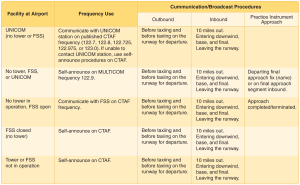Your flights normally begin and end at an airport. An airport may be a small sod field or a large complex utilized by air carriers. This week we’ll be thinking about the two types of airports: towered and nontowered. These introductions to the two airport types come from the FAA textbook Pilot’s Handbook of Aeronautical Knowledge.
Towered Airports
A towered airport has an operating control tower. Air traffic control (ATC) is responsible for providing the safe, orderly, and expeditious fl ow of air traffic at airports where the type of operations and/or volume of traffic requires such a service. Pilots operating from a towered airport are required to maintain two-way radio communication with air traffic controllers, and to acknowledge and comply with their instructions. Pilots must advise ATC if they cannot comply with the instructions issued and request amended instructions. A pilot may deviate from an air traffic instruction in an emergency, but must advise ATC of the deviation as soon as possible.
Nontowered Airports
An nontowered airport does not have an operating control tower. Two-way radio communications are not required, although it is a good operating practice for pilots to transmit their intentions on the specified frequency for the benefit of other traffic in the area. The key to communicating at an airport without an operating control tower is selection of the correct common frequency. The acronym CTAF, which stands for Common Traffic Advisory Frequency, is synonymous with this program. A CTAF is a frequency designated for the purpose of carrying out airport advisory practices while operating to or from an airport without an operating control tower. The CTAF may be a Universal Integrated Community (UNICOM), MULTICOM, Flight Service Station (FSS), or tower frequency and is identified in appropriate aeronautical publications. UNICOM is a nongovernment air/ground radio communication station which may provide airport information at public use airports where there is no tower or FSS. On pilot request, UNICOM stations may provide pilots with weather information, wind direction, the recommended runway, or other necessary information. If the UNICOM frequency is designated as the CTAF, it will be identified in appropriate aeronautical publications.
We’ll have more on airport operations on Thursday, with a special guest post from NAFI Master Flight Instructor and FAA DPE Jason Blair!





